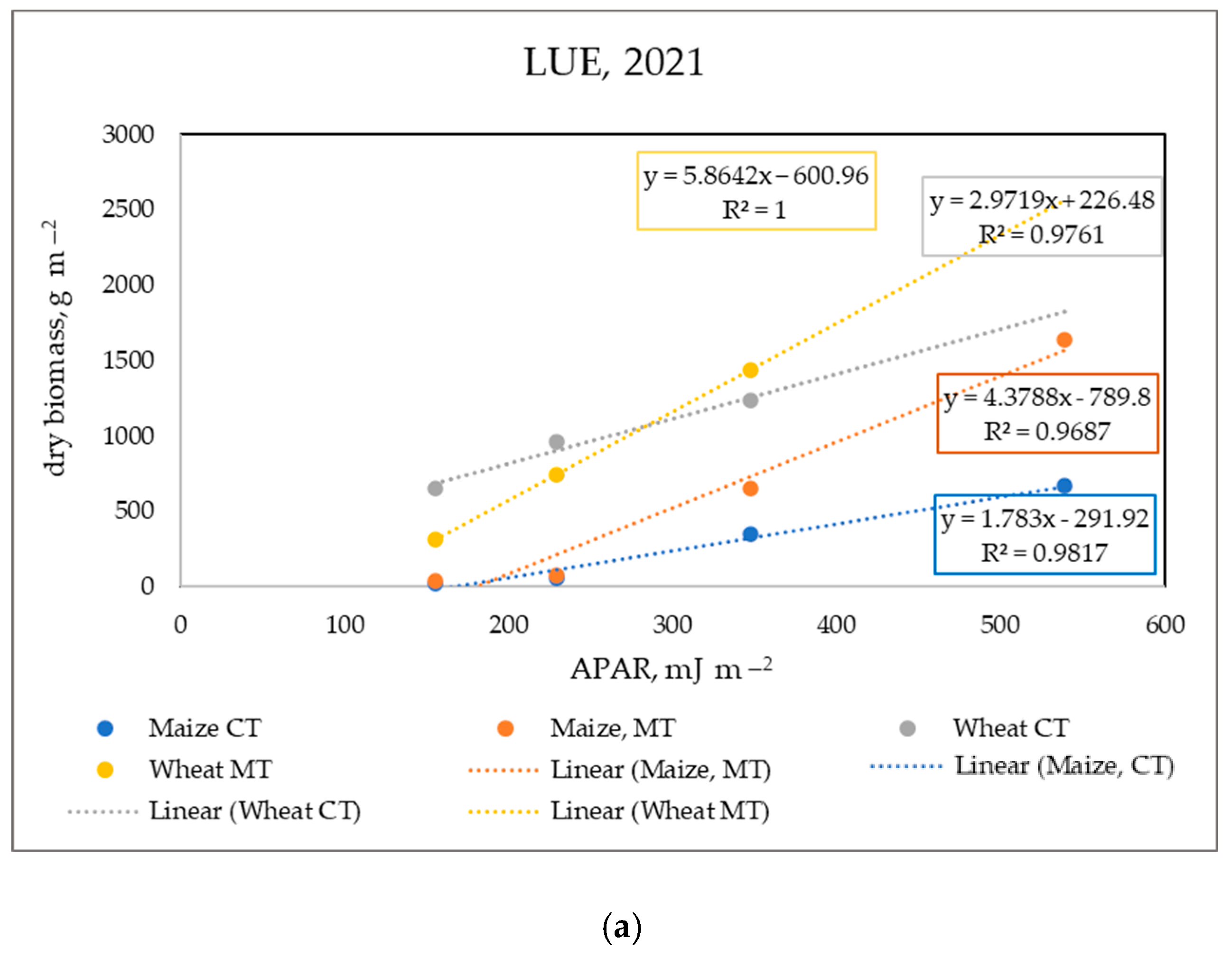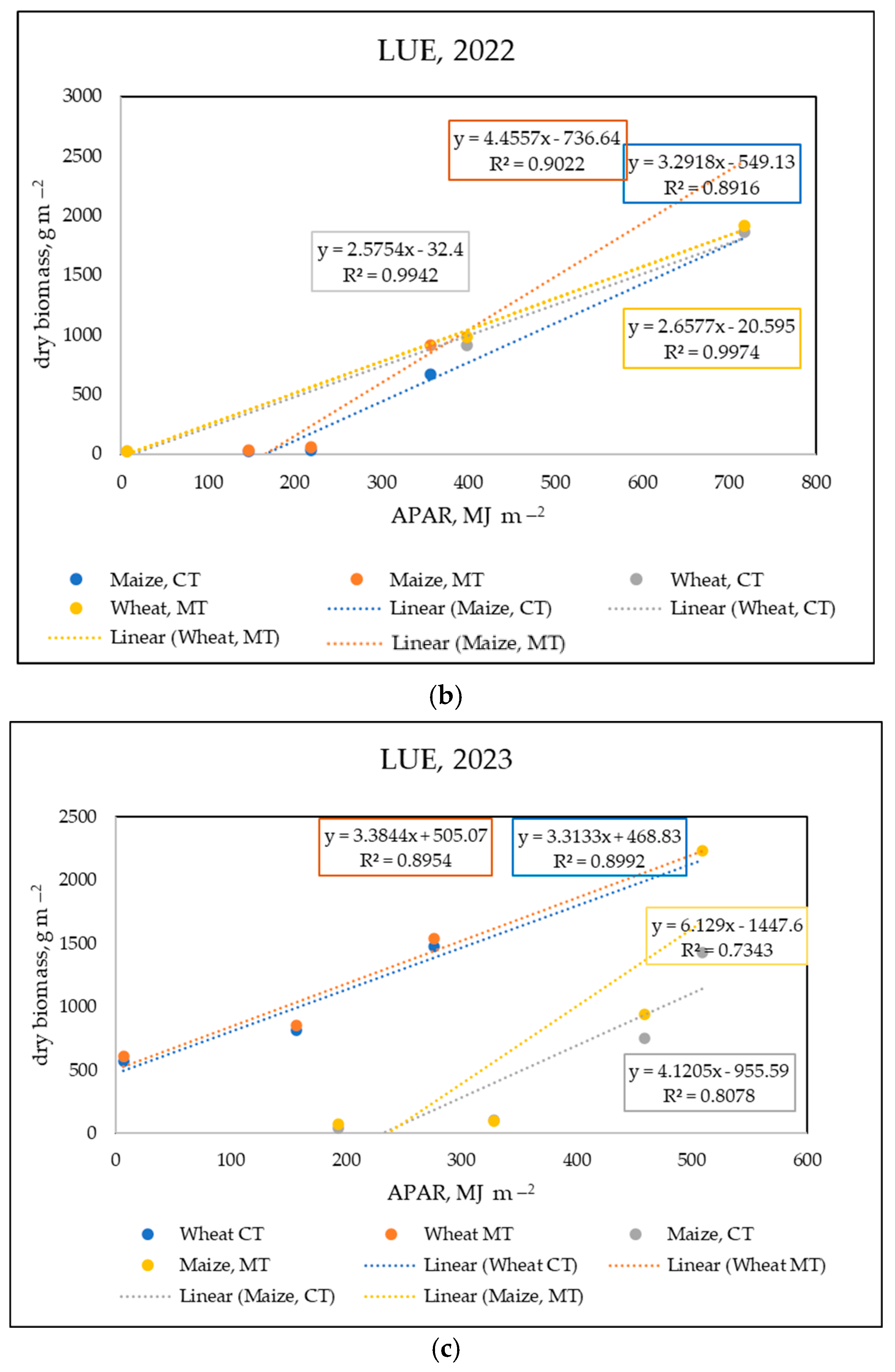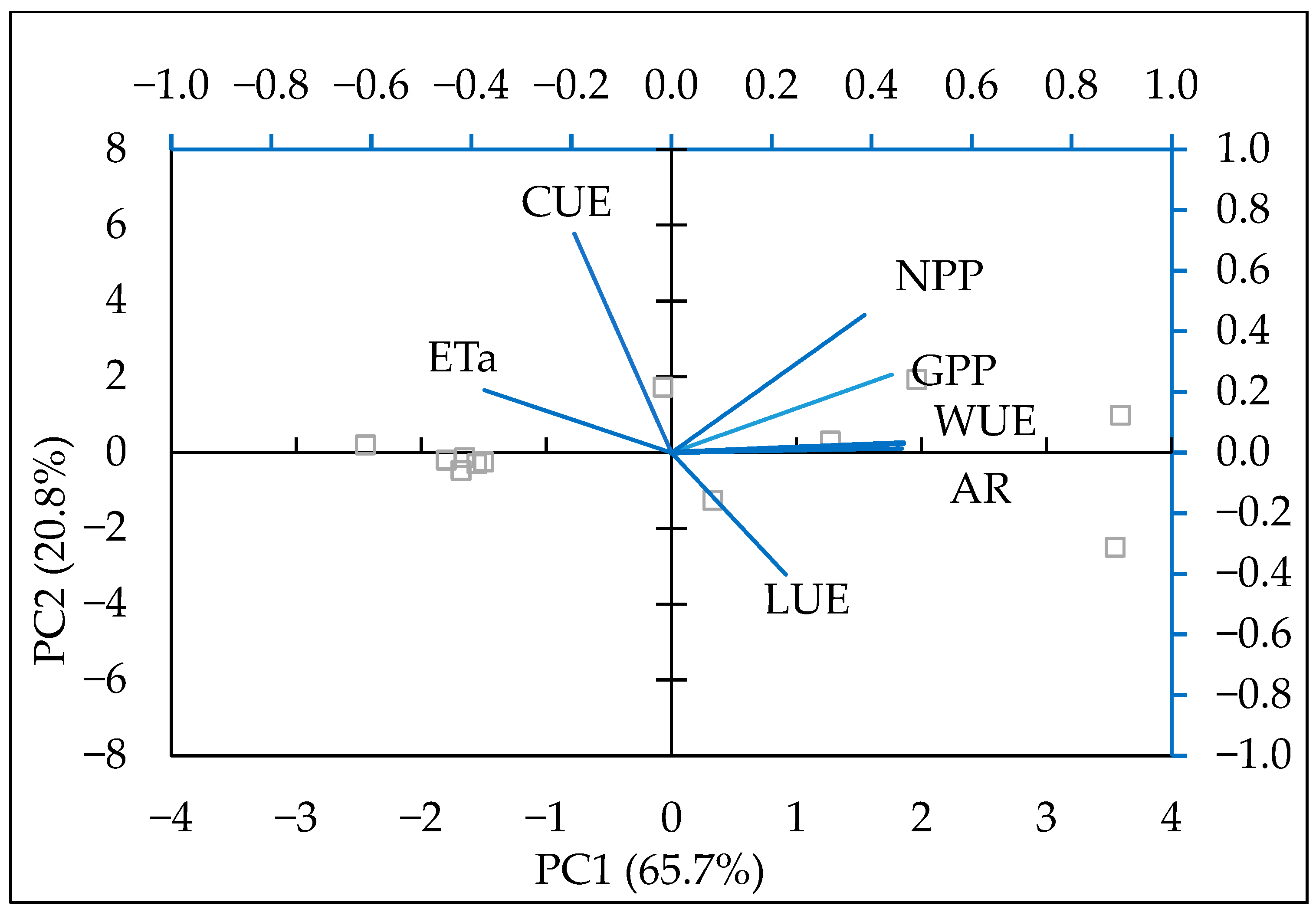1. Introduction
Agroecosystems cover approximately 30% of the Earth’s surface [
1] and provide essential ecosystem services related to the cycling of elements, water, and carbon [
2,
3]. The environmental impact of these systems is largely determined by the agricultural practices employed [
4]. Conventional farming techniques, although productive, are highly resource-intensive and contribute to soil degradation, loss of organic matter, compaction, erosion, and biodiversity decline.
Climate change further amplifies these issues by altering hydrological cycles, including shifts in precipitation patterns, temperature, and radiation levels [
5,
6,
7,
8,
9]. These factors increase drought and erosion risks [
10], with erosion being one of the main drivers of soil degradation globally [
11]. Climate projections suggest intensified water erosion across various future scenarios [
12].
The interconnection between carbon and water cycles is central to agroecosystem functioning [
13], with plant transpiration accounting for roughly 60% of terrestrial evapotranspiration [
14], second only to precipitation [
15]. Meanwhile, photosynthesis is the primary flux of the carbon cycle. These processes are often modeled together through stomatal conductance, linking evapotranspiration and carbon assimilation [
16,
17]. Water use efficiency (WUE), defined as the biomass produced per unit of water used, serves as a key indicator of these linkages [
18].
Resource use efficiency—including water, nutrients, light, and carbon—is critical in agricultural systems [
19,
20]. However, rising temperatures and atmospheric CO
2, along with reduced water availability, increasingly challenge these efficiencies [
21,
22,
23,
24]. Some studies suggest that under certain conditions, agroecosystems can adjust to maintain or even improve resource use efficiency [
25,
26].
Agricultural practices have a profound impact on resource efficiency [
27], and the development of integrated indicators is vital for sustainable production [
28]. Conservation tillage, for instance, has shown promise in improving soil structure, yield, and WUE [
29]. Carbon dynamics in agroecosystems are also heavily influenced by management strategies and local environmental conditions [
30,
31]. Because of this complexity, multi-year measurements across diverse landscapes are essential.
Plant production not only regulates the input of organic matter formed during the photosynthetic process into the soil but also plays a crucial role in reducing atmospheric carbon levels through sequestration. This process is a key factor in mitigating global warming [
32,
33]. Understanding the efficiency of resource use in agricultural systems is essential for optimizing productivity while minimizing environmental impacts.
Light use efficiency (LUE), WUE, and carbon use efficiency (CUE) are commonly analyzed at the ecosystem level, but there remains a lack of studies examining these indicators in different cropping systems, particularly in relation to conservation practices. Most of the previous research has focused on flat or less erosion-prone terrains and has emphasized yield, soil quality, and carbon sequestration outcomes. However, such settings often underestimate the compounded impact of water and soil losses found in sloped landscapes. Given the increased vulnerability of sloping terrain to erosion and runoff, understanding how cover cropping and reduced tillage affect resource use efficiencies in such settings is both timely and necessary.
This study addresses this gap by examining a wheat–maize rotation system under conservation agriculture on sloped arable land. It evaluates how cover crops and minimum tillage influence key components of the carbon balance, along with water, light, and carbon use efficiencies. In doing so, it also contrasts these findings with established results from flatter landscapes, adding a comparative dimension to the analysis. By incorporating carbon use efficiency—a less commonly addressed but equally important metric—this study offers new insights into why some conservation benefits may plateau, as seen in our results (where CUE remained unchanged). These findings have important implications for sustainable land management, particularly in erosion-prone environments under climate stress.
2. Materials and Methods
2.1. Site Description
This experiment was conducted under rainfed conditions in a field designated for erosion control at ISSAPP Nikola Pushkarov. The experimental field is located in the Danube Plain, northern Bulgaria, on moderately eroded Calcic Chernozem [
34] (with a slope of 5° (8.7%), near the village of Trastenik, Ruse District (43.478° N, 25.901° E, H = 114 m a.s.l). The topography of the area varies from flat to hilly. In the Ruse District, the largest proportion of land (48%) consists of areas with slopes ranging from 3–6° to 6–9°. The erosion rate for 91% of precipitation in the region exceeds 601 MJ mm ha
−1 [
35,
36], indicating a high potential risk of sheet water erosion. The basic soil properties of the Epicalcic Chernozem are presented in (
Table 1), including both physical (sand, silt, and clay content) and chemical characteristics (CaCO
3 content and pH). Based on the particle size distribution, the soil texture is classified as silty loam (SiL) according to the USDA soil texture classification.
The climate is temperate continental, characterized by strong continental influences.
2.2. Experimental Design
This study assessed the effects of two tillage systems within a winter wheat–maize crop rotation over three consecutive years. This experiment was conducted on field plots with a total area of 4800 m2 and consisted of four replicated treatments arranged along the slope. Each replicate included two tillage systems as follows:
Runoff measurement plots were installed in the first replicate of each treatment to monitor water runoff and soil loss. All treatments were applied simultaneously under identical agronomic and climatic conditions.
The layout of the experimental plots, including crop rotations and tillage directions, is illustrated in
Figure 1.
2.3. Runoff Measurements, Evapotranspiration Assessment, and Water Use Efficiency
Surface water runoff and soil erosion were measured using a stationary method with runoff sites covering an area of 40 m2 and runoff collection chambers.
Reference evapotranspiration (ETo) was calculated using the Penman–Monteith method, as described in the FAO 56 methodology [
37]. The FAO 56 procedure was applied to estimate evapotranspiration based on the daily soil–water balance approach.
The components of the soil–water balance were computed daily following the methodology outlined in FAO 56. Under rainfed conditions, the depletion of soil moisture in the root zone (
) on day
was calculated as follows:
where
(mm) is the soil moisture depletion on day
,
(mm) is the rainfall,
(mm) is the run-off,
(mm) is the deep percolation, and
(mm) is the actual crop evapotranspiration.
2.4. Estimation of Net Primary Productivity, Gross Primary Productivity, and Carbon Use Efficiency
For the estimation of net primary productivity (NPP) and gross primary productivity (GPP), we followed the approach described in [
38] and the STICS model.
Net primary productivity (NPP) was calculated as the daily change in the total carbon content (TCC) of both the aboveground and belowground plant biomass [
39]. Biomass was multiplied by the carbon content coefficient:
Belowground NPP was derived using a constant coefficient based on shoot-to-root ratios and harvest indices. Various approaches exist, such as the method described in [
38], which incorporates a root + rhizodeposition coefficient: 0.59 for maize; 1.5 for winter wheat before the maximal rate of leaf growth (end of the juvenile phase); 0.43 between the maximal rate of leaf growth and flowering; 0.33 after flowering; and 1.5 for cover crops terminated before booting. However, in this study, we applied a coefficient of 2.46, as proposed by [
40].
where
is gross primary productivity (kg C m
−2),
is net primary productivity (kg C m
−2), and
is autotrophic respiration (kg C m
−2).
Autotrophic respiration (AR) was calculated following the procedure described in [
38,
41]:
where
is growth respiration and
is maintenance respiration.
Growth respiration (GR) represents the CO
2 emitted as a byproduct of growth processes. Based on the amount of glucose required to synthesize 1 g of plant material, ref. [
41] proposed a coefficient of 0.28 (within the range of [0.25, 0.29]).
was calculated on day
i as a function of GPP on day
i − 1 [
36].
Initial values GPP1 and GR1 are null, for each crop, before sowing.
where
is the temperature coefficient of respiration, equal to 2;
is the aboveground autotrophic respiration;
are the empirical coefficients, with values of 2.16 and −0.66, respectively;
is the temperature (°C);
is the nitrogen content of the plant tissue (%);
is the aboveground biomass (kg m
−2 day
−1) [
38].
Carbon use efficiency was calculated as [
42]:
2.5. Estimation of Water Use Efficiency
Water Use Efficiency (
kg m
−2 mm
−1) expresses the relationship between biomass production and water consumption. In this study, WUE was calculated as the ratio between gross primary production (
) and actual evapotranspiration (
), according to Equation (9) [
42]:
where
is the gross primary production (kg m
−2), estimated based on aboveground biomass accumulation, and
is the actual evapotranspiration (mm), representing the total water loss from the system through both evaporation and plant transpiration.
To estimate GPP, aboveground biomass was sampled at the beginning of each phenological stage. Biomass was collected using wooden frames of known dimensions. All vegetation within each frame was harvested, oven-dried at 105 °C until a constant weight was achieved, and weighed to determine dry matter. Three replicates were collected per sampling event to ensure accuracy.
2.6. Estimation of Light Use Efficiency
We employed the equation of Hargreaves [
43] (Equation (10)) to calculate the day/night sums of total solar radiation
:
where
is the total solar radiation in the absence of the atmosphere (MJ m
−2 day
−1),
and
are the maximum and minimum air temperatures (°C), and
is the empirical coefficient. The calculation was performed using the equation with an average coefficient
= 0.14 °C
−1/2, which was obtained for the period 2010–2015 from an automatic meteorological station.
The efficiency of solar radiation use during the vegetation period (LUE, g MJ
−1) is defined as the slope of the linear regression of aboveground biomass accumulated across developmental phases versus the incident of photosynthetically active radiation (PAR) in cumulative form. Available data allow the calculation of light use efficiency (LUE) in terms of the absorbed fraction of photosynthetically active radiation (APAR) within the 400–700 nm spectrum. Given that chlorophyll primarily absorbs in the blue and red regions, the fraction of PAR absorbed by leaves is estimated as APAR = 0.85 PAR [
44].
The efficiency of solar radiation use for the growing season (LUE, gMJ−1) was determined as the slope of a linear regression dependence of aboveground biomass accumulated by development phases on APAR in cumulative form.
2.7. Statistical Analysis
A one-way analysis of variance (ANOVA) was conducted to assess significant differences in water runoff, soil loss, and data from entire crop rotations. Additionally, a multifactor ANOVA was applied to evaluate other parameters, with tillage, year, and crop type considered as controlling factors. Principal component analysis (PCA) and Spearman correlation analysis were employed to identify interactions among the analyzed parameters. To determine the statistical significance of the observed correlations, Spearman rank correlation coefficients were calculated for each pair of variables, followed by significance testing using p-values. All analyses were performed using STATGRAPHICS Plus.
4. Discussion
Soils today are greatly impacted by human activities such as deforestation, industrial agriculture, urbanization, and pollution. These anthropogenic pressures have led to widespread soil degradation, erosion, salinization, and desertification, thereby undermining essential ecosystem services [
48]. This leads to various environmental issues, including soil degradation, loss of organic matter, compaction, intensified erosion, deterioration of soil structure, and a decline in biodiversity [
49]. Among conservation measures, cover crops are increasingly recognized for their multifunctional role in improving soil health and delivering ecosystem services [
50]. They reduce erosion, mitigate compaction, enhance soil structure, and increase organic carbon, microbial activity, and nutrient cycling. Despite their potential, studies remain divided on their impact on subsequent crop yields and water use efficiency (WUE) [
51], with some reporting positive [
52,
53] and others negative effects [
54].
Minimizing tillage, early sowing, no-till practices, etc., can positively influence water use efficiency (WUE) [
55]. Our results support findings that cover crops can improve subsequent crop development and resource use, particularly in erosion-prone sloping terrains—a context less frequently studied in the literature. Specifically, we observed enhanced WUE in maize after cover cropping, especially in the drier years (2022–2023), suggesting that conservation practices may stabilize yields under water-limited conditions. This is consistent with previous findings that improved water retention due to organic residues and erosion control may offset early-season moisture depletion caused by cover crops [
56,
57].
However, the effect varied by crop and tillage intensity. While maize benefited significantly, wheat showed a weaker response to conservation tillage, confirming earlier studies that highlight variable responses across crop types and climates [
55,
58]. Our observations underscore the need to consider crop-specific and terrain-related dynamics when evaluating conservation strategies.
Regarding carbon use efficiency (CUE), our study observed no statistically significant variation across treatments or years, even under markedly different climatic conditions (wet in 2021 vs. drought in 2023). This result aligns with the earlier research indicating that CUE can remain stable despite environmental variability due to internal plant regulatory mechanisms and carbon allocation strategies that prioritize maintenance respiration under stress [
45,
46,
59]. Although ecosystem-level studies have reported seasonal CUE variation in response to soil moisture and temperature [
60], our findings suggest that in annual cropping systems, such as maize and wheat, this response may be buffered by management practices like residue retention and minimized tillage.
The unchanged CUE across treatments may also reflect a trade-off between carbon assimilation and autotrophic respiration. Under conservation systems, improved soil conditions can support higher microbial and root activity, potentially increasing autotrophic respiration and counterbalancing gains in gross primary productivity. This supports the hypothesis that CUE stability under different agricultural practices may not indicate inefficiency but rather a dynamic equilibrium within the carbon cycle [
60].
While previous research has emphasized WUE and LUE in conservation agriculture, fewer studies have incorporated CUE as a metric of resource efficiency. Our findings thus contribute new insights by showing that, even when biomass and WUE increase under conservation practices, CUE may remain stable—highlighting the importance of including all three metrics for a holistic understanding of agroecosystem functioning.
CUE and WUE often respond differently to environmental changes and land management, as also shown in spatial and temporal studies [
61]. While a weak but positive correlation between WUE and LUE was found in our study, PCA further revealed a synergistic interaction between the two. This supports previous assertions that optimizing one resource use efficiency may indirectly influence another, though not always linearly [
20,
62]. Moreover, the superior WUE of maize (a C4 crop) compared with wheat (a C3 crop) aligns with established physiological differences [
63].
Overall, our results emphasize that conservation practices on sloping terrain not only mitigate erosion but also enhance biomass accumulation and WUE, especially in maize, while maintaining CUE stability. These findings provide a deeper understanding of resource use dynamics in vulnerable landscapes and advance the current knowledge by incorporating terrain sensitivity and CUE analysis into the broader context of sustainable agricultural intensification.
Nevertheless, the observed year-to-year variability in crop yield and resource use efficiency highlights the influence of climatic fluctuations and crop-specific responses. Future studies should aim to incorporate multi-year data across diverse agroecosystems to better capture the spatial and temporal dynamics of carbon fluxes and resource efficiency.
Moreover, given the relatively short three-year duration of this study, the long-term sustainability impact on soil fertility, microbial communities, and ecosystem stability remains uncertain and warrants further investigation through long-term monitoring [
64].
5. Conclusions
In the current study, we observed that planting a cover crop on sloping arable land exposed to water erosion processes significantly improves biomass accumulation in the subsequent crop while reducing surface water runoff and soil losses. The inclusion of a cover crop in the wheat–maize rotation leads to a substantial increase in assimilated carbon, enhancing both aboveground and belowground biomass. This process aids in carbon sequestration, keeping the soil surface covered during the fallow periods between main crops. Moreover, when combined with minimum contour tillage, this approach results in more efficient water management for both maize and wheat crops, particularly improving water and light use efficiency in the dry years of 2022 and 2023.
While our study demonstrated that these conservation practices can enhance resource use efficiency, it is important to note that carbon use efficiency (CUE) did not show significant differences in relation to tillage systems or climatic conditions during the course of this experiment. This suggests that, while the system improves biomass and resource efficiency, further investigation is needed to better understand the complex factors influencing carbon cycling under varying management practices.
There are several limitations to our study that should be addressed in future research. First, this study was conducted over a limited number of years, and longer term monitoring is necessary to assess the sustainability of these practices over time. Additionally, this research was focused on a single agroecosystem with specific climatic and soil conditions. To draw more generalized conclusions, similar studies should be conducted in different geographic regions and under various climate scenarios.
The practical applications of our findings are significant for sustainable agricultural practices in sloping terrains prone to erosion. Our results suggest that the integration of cover crops and minimum tillage can be a viable strategy to improve soil conservation, enhance water and light use efficiency, and increase carbon sequestration in agroecosystems. This approach could be particularly beneficial for farmers in regions affected by soil erosion and water scarcity.
Future research should focus on a deeper exploration of the underlying mechanisms that regulate carbon cycling and use efficiency in different agricultural systems. It would also be valuable to study the long-term effects of these practices on soil fertility, biodiversity, and overall ecosystem services. Further experiments could explore the potential of other cover crop species, varying tillage practices, and the impact of climate change on the efficacy of these conservation techniques.





















